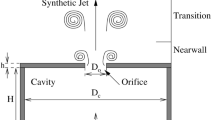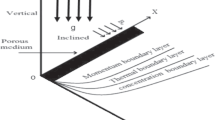Abstract
The jet-flow high shear mixer (JF-HSM) is a new type of intensified equipment with special configurations of the rotor and the stator. The mass transfer property and power consumption were studied in the solid-liquid system for a series of JF-HSMs involving different configuration parameters, such as rotor diameter, rotor blade inclination, rotor blade bending direction, stator diameter, and stator bottom opening diameter. The flow characteristics were examined by computational fluid dynamic simulations. Results indicate that the turbulent power consumption of the JF-HSM is affected by the change in rotor blade inclination and stator bottom opening. With the increase in the shear head size and the change in the rotor into a backward-curved blade, the solid-liquid mass transfer rate can be remarkably increased under the same input power. Dimensionless correlations for the mass transfer coefficient and power consumption were obtained to guide the scale-up design and selection of such a new type of equipment to intensify the overall mixing efficiency.

Similar content being viewed by others
References
John T P, Fonte C P, Kowalski A, Rodgers T L. A comparison of power and flow characteristics between batch and in-line rotor-stator mixers. Chemical Engineering Science, 2019, 202: 481–490
James J, Cooke M, Trinh L, Hou R, Martin P, Kowalski A, Rodgers T L. Scale-up of batch rotor–stator mixers. Part 1—power constants. Chemical Engineering Research & Design, 2017, 124: 313–320
Utomo A T, Baker M, Pacek A W. Flow pattern, periodicity and energy dissipation in a batch rotor–stator mixer. Chemical Engineering Research & Design, 2008, 86(12): 1397–1409
Qin H, Xu Q, Li W, Dang X, Han Y, Lei K, Zhou L, Zhang J. Effect of stator geometry on the emulsification and extraction in the inline single-row blade-screen high shear mixer. Industrial & Engineering Chemistry Research, 2017, 56(33): 9376–9388
Shiba R, Uddin M A, Kato Y, Kitamura S Y. Solid/liquid mass transfer correlated to mixing pattern in a mechanically-stirred vessel. Iron and Steel Institute of Japan International, 2014, 54(12): 2754–2760
Yang L, Cheng J, Fan P, Yang C, Mao Z. Micromixing of solidliquid systems in a stirred tank with double impellers. Chemical Engineering & Technology, 2013, 36(3): 443–449
Chen G, Luo G, Xu J, Wang J. Preparation of barium sulfate particles using filtration dispersion precipitation method in O/W system. Powder Technology, 2005, 153(2): 90–94
Montante G, Carletti C, Maluta F, Paglianti A. Solid dissolution and liquid mixing in turbulent stirred tanks. Chemical Engineering & Technology, 2019, 42(8): 1627–1634
Stoian D, Eshtiaghi N, Wu J, Parthasarathy R. Enhancing impeller power efficiency and solid–liquid mass transfer in an agitated vessel with dual impellers through process intensification. Industrial & Engineering Chemistry Research, 2017, 56(24): 7021–7036
Tokura Y, Uddin M A, Kato Y. Effect of suspension pattern of sedimentary particles on solid/liquid mass transfer in a mechanically stirred vessel. Industrial & Engineering Chemistry Research, 2019, 58(24): 10172–10178
Viten’ko T N, Gumnitskii Y M. Mass transfer during dissolution of solids using hydrodynamic cavitation devices. Theoretical Foundations of Chemical Engineering, 2006, 40(6): 598–603
Myers K J, Reeder M F, Ryan D. Power draw of a high-shear homogenizer. Canadian Journal of Chemical Engineering, 2001, 79(1): 94–99
Padron G. Measurement and comparison of power draw in batch rotor-stator mixers. Dissertation for the Master’s Degree. Maryland: University of Maryland, 2001, 126–127
Doucet L, Ascanio G, Tanguy P A. Hydrodynamics characterization of rotor-stator mixer with viscous fluids. Chemical Engineering Research & Design, 2005, 83(10): 1186–1195
James J, Cooke M, Kowalski A, Rodgers T L. Scale-up of batch rotor-stator mixers. Part 2—Mixing and emulsification. Chemical Engineering Research & Design, 2017, 124: 321–329
Carletti C, Montante G, De Blasio C, Paglianti A. Liquid mixing dynamics in slurry stirred tanks based on electrical resistance tomography. Chemical Engineering Science, 2016, 152: 478–487
Altheimer M, Becker D, D’Aleo F P, Rudolf von Rohr P. Flow regime and liquid–solid mass transfer investigation in a designed porous structure using electrochemical micro-probes. Chemical Engineering Science, 2016, 152: 699–708
Paglianti A, Carletti C, Busciglio A, Montante G. Solid distribution and mixing time in stirred tanks: The case of floating particles. Canadian Journal of Chemical Engineering, 2017, 95(9): 1789–1799
Koganti V, Carroll F, Ferraina R, Falk R, Waghmare Y, Berry M, Liu Y, Norris K, Leasure R, Gaudio J. Application of modeling to scale-up dissolution in pharmaceutical manufacturing. American Association of Pharmaceutical Scientists PharmSciTech, 2010, 11(4): 1541–1548
Håkansson A, Mortensen H H, Andersson R, Innings F. Experimental investigations of turbulent fragmenting stresses in a rotorstator mixer. Part 1. Estimation of turbulent stresses and comparison to breakup visualizations. Chemical Engineering Science, 2017, 171: 625–637
Qi N, Wang H, Zhang K, Zhang H. Numerical simulation of fluid dynamics in the stirred tank by the SSG Reynolds Stress Model. Frontiers of Chemical Engineering in China, 2010, 4(4): 506–514
Jasińska M. Test reactions to study efficiency of mixing. Chemical & Process Engineering, 2015, 36(2): 171–208
John T P, Panesar J S, Kowalski A, Rodgers T L P, Fonte C. Linking power and flow in rotor-stator mixers. Chemical Engineering Science, 2019, 207: 504–515
Xu S, Cheng Q, Li W, Zhang J. LDA measurements and CFD simulations of an in-line high shear mixer with ultrafine teeth. AIChE Journal. American Institute of Chemical Engineers, 2014, 60(3): 1143–1155
Levins D, Glastonbury J. Application of Kolmogorofff’s theory to particle—liquid mass transfer in agitated vessels. Chemical Engineering Science, 1972, 27(3): 537–543
Harriott P. Mass transfer to particles: Part I. Suspended in agitated tanks. AIChE Journal. American Institute of Chemical Engineers, 1962, 8(1): 93–101
Nienow A W, Miles D. The effect of impeller/tank, configurations on fluid-particle mass transfer. Chemical Engineering Journal, 1978, 15(1): 13–24
Pangarkar V G, Yawalkar A A, Sharma M M, Beenackers A A C M. Particle-liquid mass transfer coefficient in two-/three-phase stirred tank reactors. Industrial & Engineering Chemistry Research, 2002, 41(17): 4141–4167
Bong E. Solid-liquid mass transfer in agitated vessels with high solids concentration. Dissertation for the Doctoral Degree. Melbourne: Royal Melbourne Institute of Technology University, 2013, 47–58
Özcan-Taşkın G, Kubicki D, Padron G. Power and flow characteristics of three rotor-stator heads. Canadian Journal of Chemical Engineering, 2011, 89(5): 1005–1017
Cooke M, Rodgers T L, Kowalski A J. Power consumption characteristics of an in-line silverson high shear mixer. AIChE Journal. American Institute of Chemical Engineers, 2012, 58(6): 1683–1692
Carletti C, Bikić S, Montante G, Paglianti A. Mass transfer in dilute solid–liquid stirred tanks. Industrial & Engineering Chemistry Research, 2018, 57(18): 6505–6515
Bong E Y, Eshtiaghi N, Wu J, Parthasarathy R. Optimum solids concentration for solids suspension and solid-–liquid mass transfer in agitated vessels. Chemical Engineering Research & Design, 2015, 100: 148–156
Acknowledgements
This work was supported by the National Key Research and Development Program of China (Grant No. 2016YFD-0501402-04), the National Natural Science Foundation of China (Grant Nos. 21776179, 21621004) and the Program for Changjiang Scholars and Innovative Research Team in University (No. IRT_15R46).
Author information
Authors and Affiliations
Corresponding authors
Rights and permissions
About this article
Cite this article
Yang, L., Li, W., Guo, J. et al. Effects of rotor and stator geometry on dissolution process and power consumption in jet-flow high shear mixers. Front. Chem. Sci. Eng. 15, 384–398 (2021). https://doi.org/10.1007/s11705-020-1928-7
Received:
Accepted:
Published:
Issue Date:
DOI: https://doi.org/10.1007/s11705-020-1928-7




